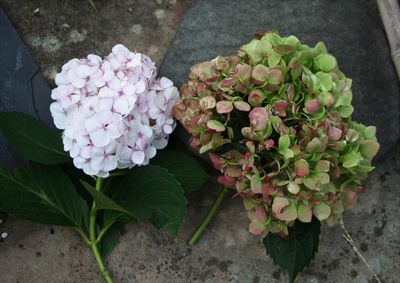
- The eBay Community
- Groups
- Fun & Social
- Community Spirit
- How did this happened - hydrengeas
- Subscribe to RSS Feed
- Mark Topic as New
- Mark Topic as Read
- Float this Topic for Current User
- Bookmark
- Subscribe
- Mute
- Printer Friendly Page
How did this happened - hydrengeas
- Mark as New
- Bookmark
- Subscribe
- Mute
- Subscribe to RSS Feed
- Highlight
- Report Inappropriate Content
on 27-03-2018 10:18 PM
Few years back I bought 3 little cuttings of hydrangea, supposedly coming from a particular deep blue bush that was pictured in the listing. I put 2 of the cuttings in large tubs, and the leftover 3rd I just poped into the ground. I also got the right blue hydrangea fertilizer.
Next year when the plants flowered I was somewhat surprised when 2 were stark white, absolutely snow white - it was one of those in tubs and the one in the ground. The other one in the second tub got green and maroon flowers. This year I still have one pure white and the other tub still has the green/maroon flowers, but the one in the ground turned from pure white to also green/maroon! But today among the green/maroon on the bush in the ground there was one baby pink with maroon spots. I always thought that in hydrangeas white will always stay white, while the blue can turn pink (and vice versa) depending on soil acidity. So, what is going on?
Here are the 2 blooms - the white is acually pink- from the same bush.
How did this happened - hydrengeas
- Mark as New
- Bookmark
- Subscribe
- Mute
- Subscribe to RSS Feed
- Highlight
- Report Inappropriate Content
27-03-2018 10:33 PM - edited 27-03-2018 10:37 PM
I think you are saying you have a pink flower amongst green / maroon flowers on the same bush ? . Two possibilities that spring to mind.
Is the mottled pinkish flower the natural Hydrangia colour with the whites being a cultivated colour ? I would have thought this to be likely. ( The blues being related to the acidity of the soil as you mention ) Plants that have been cultivated for specific colours often revert back to the original on part of a bush. This happens regularly with golden diosmas, coprosmas & privets that have green branches appear on the bush. The dominant original coloured branch needs to be removed to retain the golden colour or over time the whole bush will revert to green.
The other possibility is that the branch is a sport. Plants can on rare occasions generate single branches that are a mutation from the normal colour. This is how a lot of specialist colour plants are originally produced. A nurseryman will spot a sport branch or whole plant and take cuttings to establish the new plant. Once they have a few plants going they often take tissue cultures in a laboratory to establish commercial quantities of the plant.
How did this happened - hydrengeas
- Mark as New
- Bookmark
- Subscribe
- Mute
- Subscribe to RSS Feed
- Highlight
- Report Inappropriate Content
on 27-03-2018 10:38 PM
The 2 flowers in the pictures are from the same bush, which last year had all pure white flowers. The other white bush is still white.
I did not know that the green mottley one is the original hydrengea color. I always only saw blue, white or pink.
How did this happened - hydrengeas
- Mark as New
- Bookmark
- Subscribe
- Mute
- Subscribe to RSS Feed
- Highlight
- Report Inappropriate Content
on 27-03-2018 11:20 PM
My green thumbed grandmother had two beautiful hyderangea plants in the front garden....one was dark blue, the other was dark pink.
They were originally from the same plant and one was fed with (I think) Epsom Salts and the other used to get a handful of rusty nails every year or so.
How did this happened - hydrengeas
- Mark as New
- Bookmark
- Subscribe
- Mute
- Subscribe to RSS Feed
- Highlight
- Report Inappropriate Content
on 28-03-2018 10:35 AM
Yes, that is how it suppose to work 🙂
But mine 2 were planted in tubs into acid potting mix, and fed the "rusty nails" that comes in powder form from garden supplies, and there is no sign of blueness. The one in the ground I have less control over, but still feed it the same.
Well here goes my plan for elegant white and blue garden. Never mind there are other pink and reds that snuck in via well meaning friends for my birthdays etc. I was just hopping there is still way to get the hydrangeas blue, at least one. Just like this:
How did this happened - hydrengeas
- Mark as New
- Bookmark
- Subscribe
- Mute
- Subscribe to RSS Feed
- Highlight
- Report Inappropriate Content
on 28-03-2018 11:11 AM
How did this happened - hydrengeas
- Mark as New
- Bookmark
- Subscribe
- Mute
- Subscribe to RSS Feed
- Highlight
- Report Inappropriate Content
on 28-03-2018 11:42 AM
Thanks for the links, but I still cannot find anything that I did not know: "Here's a hint: The level of acidity in the soil affects the flower color of blue and pink varieties." and they also say that the white stays white. Never mind I will just give them more aluminum sulfate, and see what will happen next year.
However, if it did not start as white, I would think I have :
Pink Shira
A relatively new mophead variety, Pink Shira Hydrangea macrophylla is a favorite for its strong stems, compact habit, and long-lasting blooms. Its flowers start out a lovely shade of lime green then turn pink or lavender (this one doesn't go blue.




